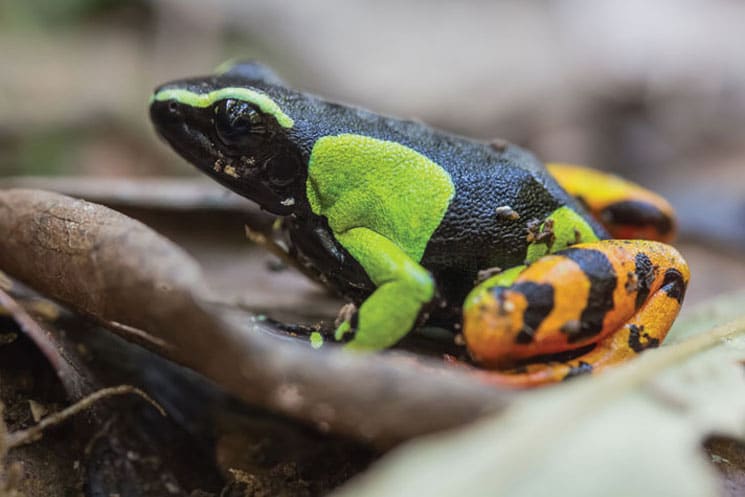Mantellas may be tiny in stature, but their appeal is enormous.
More than 20 years ago, during a trip to the zoo, one exhibit caught my eye. It was simple, underwhelming, and did not house the rarest or most elusive animals at the zoo, but it stopped me dead in my tracks. It was a cube measuring about 3 feet with a concrete background and a dripping wall covered in moss. In the confines of this glass box, about 30 adult golden mantellas (Mantella aurantiaca) hopped about, easily visible from across the room. The contrast between the emerald green moss and construction-cone orange frogs was startling. This event sparked my interest in frogs, one that eventually led to my overseeing one of the largest frog breeding operations in the U.S.
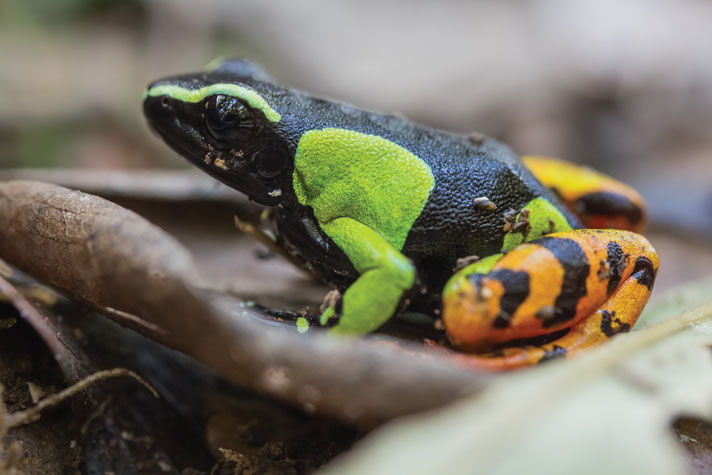
dudarev mikhail/shutterstock
Baron’s mantella (M. baroni) is also known as the painted mantella, leading to confusion between it and M. madagascariensis, which also is known as the painted mantella.
Mantellas are small — most are less than 1 inch long at adulthood — colorful frogs that are endemic to the island of Madagascar. Their striking coloration is used to warn potential predators that they are toxic, much like the dart frogs of Central and South America. Even though these two groups of frogs are similar visually, they are not closely related. This is a perfect example of convergent evolution, where two unrelated animals evolve similar adaptations independently.
Poison Frogs of the Genus Mantella
Toxins aside — and it’s worth noting that both mantellas and dart frogs lose their toxicity in captivity as a result of their captive diets — these colorful anurans make great pets when cared for properly. We’ll go through some basics on mantella care and breeding later, but the first step, of course, is knowing where to get mantellas.
Acquiring Mantellas
Unfortunately, captive-bred mantellas are by no means commonplace. Compared to many other frog species, mantellas can be fairly difficult to breed. That, coupled with their small morphing size and delicate disposition early in life may make purchasing captive-bred mantellas a challenge.
Still, I strongly encourage you to make every effort to buy captive-bred mantellas if at all possible. They may be difficult to find and more expensive than wild-caught mantellas you may encounter, but they will be much easier to keep.
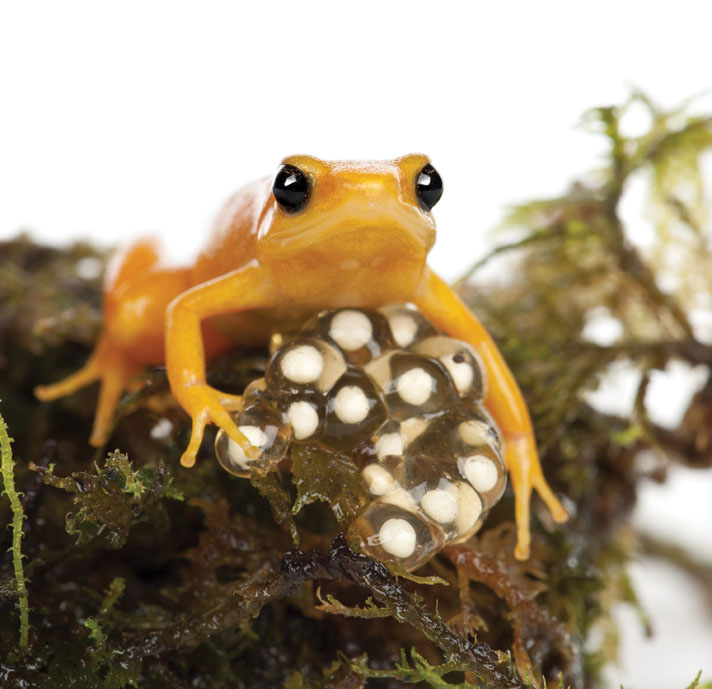
eric isselee/shutterstock
The golden mantella can be a prolific breeder in captivity. Here’s one with a clutch of eggs.
Most captive-bred mantellas are produced by dedicated hobbyists, and online groups, such as the International Mantella Society Facebook group, are a great place to start looking. Some of the larger breeders, such as Josh’s Frogs in the U.S. and Understory Enterprises in Canada, have been working to meet the demand for mantellas with captive-bred frogs, and offspring of many species are often available seasonally.
Remember, if given the option, always buy captive-bred animals. The purchase price may be higher, but will doing so will likely save you money in the end.
Wild-caught mantellas are seasonally imported from Madagascar, although rumors abound that the international importation of amphibians into the U.S. may come to an end in 2018. Some importers and retailers will take the time necessary to treat and acclimate wild-caught mantellas, but they are in the minority. Wild-caught mantellas largely tend to require treatment for parasites, and we’ve even run into fresh imports with chytrid and ranavirus!
If you do purchase wild-caught frogs, plan to take them to an experienced exotics vet — if you need one, the Association of Reptile and Amphibian Veterinarians website at ARAV.org is a great resource — and be prepared to administer medication. Quarantine any new arrivals until they are checked out and treated.
Make sure that the mantellas you are purchasing are at least three months out of the water, as younger froglets tend to be very sensitive and do not travel well. Look for frogs with no visible injuries and that are active when disturbed. Stay away from animals that are excessively skinny or appear bloated, as these conditions may indicate any of a variety of possible maladies. If you’re unsure of a mantella’s health, pass and find another source.
Mantellas In The Hobby
Of the approximately 16 species of mantella that occur in Madagascar, only a handful are now available with any kind of regularity in the pet trade.
- Golden mantella (M. aurantiaca). Probably the best-known of the mantellas, the golden is typically solid orange in color, though occasional specimens lean toward more yellow or red. The vibrant color, coupled with the frog’s solid black eyes, bold nature and diurnal habits, make the golden mantella a popular pet. Even though the golden mantella is critically endangered in the wild, it is still imported with some regularity for the pet trade. That said, remember to seek out captive-bred animals because they’re much hardier than their wild-caught counterparts and by purchasing them you’re not contributing to the decrease of wild populations in Madagascar. Fortunately, the golden mantella can be quite prolific in captivity. It tends to breed seasonally, but in large numbers. One breeding group of 15 animals produced 14 egg clutches in a week!
- Baron’s or painted mantella (M. baroni). Named for its original collector, Baron’s mantella is also known as the painted mantella for good reason. A black frog with orange and black, tiger-striped rear legs and emerald green (sometimes yellow) front legs and shoulders, this mantella certainly stands out in the vivarium! It’s a larger species that can prove a bit challenging to breed consistently. Interestingly, there is a giant form of this mantella, as well, although it is much less common in the hobby.
- Brown mantella (M. betsileo). The brown mantella is one of the least colorful species of the genus. It’s still imported regularly and not often bred in captivity, most likely due to lack of trying. We bred the brown mantella for the first time at Josh’s Frogs in 2017, and it seems to breed as easily, if not moreso, than many other species.
- Painted mantella (M. madagascariensis). This mantella closely resembles M. baroni, but with a few key differences. In fact, the vast majority of the times we’ve attempted to acquire M. madagascariensis, the frogs ended up being M. baroni. Occasionally, a few M. madagascariensis will be mixed in with M. baroni imports, so it pays to closely examine the frogs you are planning on purchasing. Mantella madagascariensis has a U-shaped blue-teal blotch, and possibly additional spots, on its throat, whereas M. baroni will have spots. The former also tends to have more orange coloration on its hind legs. The two species’ similar appearance, coupled with an overlapping common name, can make acquiring an actual painted mantellas quite a chore.
- Beautiful mantella (M. pulchra). Although it isn’t the most colorful species in the genus, the beautiful mantella certainly earns its common name. A smaller species, these primarily brown frogs have lighter rear legs and green patches around their front legs. Offspring often have orange hind legs for the first several months of their life. This species takes well to captivity and breeds like rabbits.
- Green mantella (M. viridis). One of, if not the largest frogs in the genus (our largest adult female measured about 11/4 inches in length), the green mantella is endangered in the wild. Fortunately, it does not appear to have been imported in recent years. Wild-caught green mantellas are a dull green in coloration, with a green stripe along their sides. Older wild-caught animals, as well as captive-bred individuals, may take on a more yellowish appearance. Difficult to breed, female green mantellas lay huge egg clutches, often numbering more than 100.
Mantella Enclosures That Are Ideal
So you’ve decided to keep mantellas — now it’s time to set up a home for them! The first step is to select the proper enclosure.
Many options are available, such as glass aquaria or specialized glass reptile terraria produced by many major manufacturers. I prefer to use an enclosure that provides a bit of cross ventilation, and many commercially available terraria include a vent below the door that really helps with this.
Most mantella species are primarily terrestrial (although one species is an exception — the climbing mantella, M. laevigata) so floor space is king.
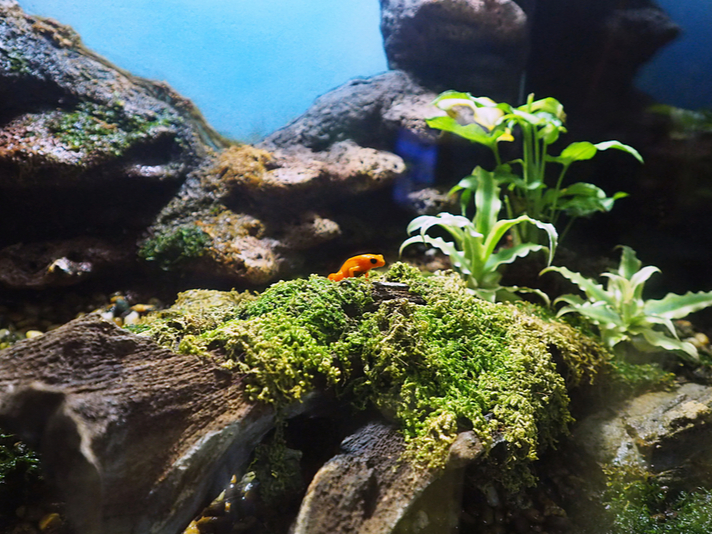
Artorn Thongtukit/Shutterstock
Mantellas thrive in a naturalistic vivarium with live plants, and if you choose to go this route, make sure to use a well-draining substrate (we use ABG Mix) and provide a drainage layer of 1 to 2 inches below the ABG.
Although mantellas can be housed in an enclosure as small as 10 gallons, the more room you can provide, the better. Choose a habitat that is at least 12 inches tall, though some extra height isn’t a bad thing because it will allow more space for live plants to grow. We use 18- by 18- by 12-inch glass tanks for up to five mantellas, and 36- by 18- by 12-inch enclosures for groups of up to 20. A secure screen top is recommended to aid in air circulation.
Once you have the enclosure chosen, housing mantellas is pretty simple as long as you start out with healthy specimens. They will thrive in a naturalistic vivarium with live plants, and if you choose to go this route, make sure to use a well-draining substrate (we use ABG Mix) and provide a drainage layer of 1 to 2 inches below the ABG, as well as leaf litter and pesticide-free plants. From the bottom up, we provide a drainage layer, substrate barrier, 2 inches of ABG mix, just enough long-fiber sphagnum moss to cover the soil and about 1 inch of leaf litter. A few pieces of moisture-resistant wood, such as cork, manzanita, or bog wood, will act as a structure for the mantellas to hide under and climb onto.
A small pond will provide a place for your mantellas to get their feet wet. I like to create ponds in the corner of mantella enclosures by using a flat piece of cork bark as a “dam.” The cork is positioned diagonally, with one end touching the front glass and the other touching a side wall, to create an open triangular space in the corner. Then I layer the substrate into the rest of the enclosure until it comes to the top of the cork bark. Doing this allows water from the drainage layer to flow into the open triangular space on the other side of the cork in to create a shallow pool. It also provides a larger water volume overall, which goes a long way toward maintaining acceptable water quality.
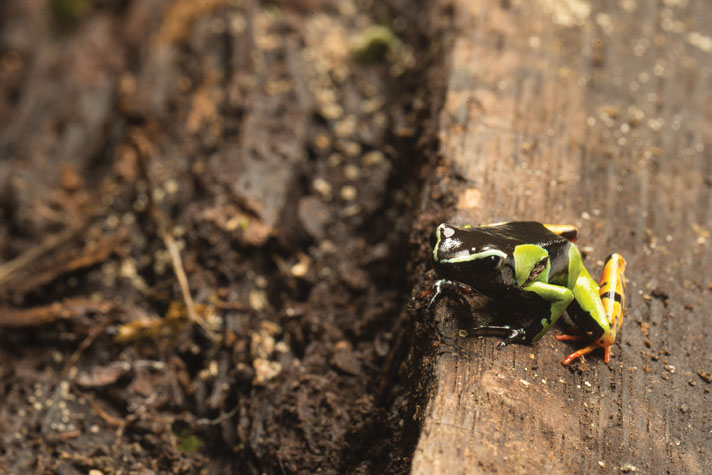
joe mcdonald/shutterstock
The painted mantella (M. madagascariensis) closely resembles the Baron’s mantella.
A naturalistic display is a great way to house mantellas that’s similar to how they would live in nature; you’re basically recreating a small slice of their natural habitat in a glass box. Also called “bioactive enclosures,” they can be a low-maintainence, beautiful addition to any home, but with one drawback: they make mantella egg and tadpole collection nearly impossible! If your goal is to breed mantellas, or you wish to house them in a less expensive, less complicated fashion, utilizing sphagnum moss, cork and foam may be the way to go.
At Josh’s Frogs, we use a 1-inch layer of specialized stable foam (called Frog Foam) as our base layer. We cut the foam so that it’s the same length as the tank, but a couple inches shorter in width so that there is a gap along the front of the tank between it and the foam layer. We then cover the foam with one or two inches of long-fiber sphagnum moss, followed by many pieces of cork bark and tubes, as well as some hardy plant cuttings (pothos is a great choice). Lastly, we add about a half-inch of water to the enclosure, which results in a shallow trench/pond along the entire front of the tank. This is our basic mantella setup and has been used to successfully house and breed many different species of these colorful frogs. They can be housed fairly densely — we average one frog per 5 gallons of tank volume, and have housed up to 20 mantellas in a single 36- by 18- by 18-inch terrarium.
Mantellas do not require any specialized lighting, but we do believe they benefit from a low-level UVB bulb — we use an Exo Terra 5.0 UVB linear fluorescent light bulb over our tanks — paired with a 6500K daylight bulb. This combination of lighting is great for both mantellas and live plants. Do not use any kind of heat lamp with your mantellas — if you do, you’ll quickly cook them.
Monitor temperature and humidity with a digital gauge. Temps from 65 to 70 degrees Fahrenheit are ideal for mantellas. Most species can tolerate temperatures up to 75 degrees, but any higher than that can be problematic, and temperatures above 80 degrees can quickly become fatal. It’s better to keep mantellas on the cool side.
Mantellas, especially young mantellas, can be extremely sensitive to warm temperatures. If you will not be able to keep adults below 75 degrees Fahrenheit, and young mantellas below 70 degrees, reconsider your decision to keep them.
Is running the A/C more often an option? Alternatively, consider moving to a cooler climate. Snow can be great fun, and your frogs will love you for moving them to a place with lower-than-average home temperatures!
These rain forest frogs like it humid, so mist their enclosure frequently or invest in an automated misting system; several are available from reptile product manufacturers. Cover about 80 percent of the screen top with a piece of glass to keep humidity in (in exceptionally arid climates, a full glass top, rather than a screen top, may be necessary). Aim for at least 70 percent humidity, with more humid areas available via standing water, humid moss, etc.
Mantellas come together in large numbers to breed in the wild, and as long as plenty of visual barriers, hiding spots, and food is provided, captive mantellas do well in groups. In fact, housing mantellas in large groups can be vital to successful reproduction, if that’s your goal.
Mantellas Of Years Past
As laws change or imports cease, many species of once-common mantellas become nearly impossible to find in the pet trade. These include the harlequin mantella (M. cowani), the yellow mantella (M. crocea), the blue-legged mantella (M. expectata) and others.
Not all hope is lost, however. Many of these species are still present in the private hobby, only available to those with experience and connections (and sometimes deep pockets). Hopefully, continued captive breeding may make these animals more readily available in the future.
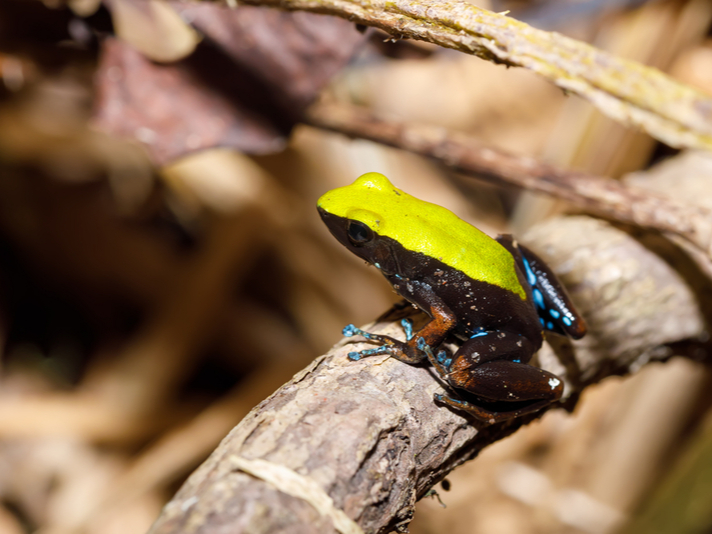
Artush/Shutterstock
While most mantellas are terrestrial, the climbing Mantella (Mantella laevigata) is more adept on tree branches.
Mantellas And Conservation
Most mantella populations (and much of Madagascar’s diverse endemic species) are in trouble. A growing human population, climate change, habitat destruction and emergent diseases have all impacted wild mantella populations. If you choose to keep mantellas, please choose to support captive breeding, if that is an option. Consider breeding them so that other hobbyists can more easily acquire captive-bred stock.
Donating funds to conservation efforts is another great way to help protect mantellas in the wild. At Josh’s Frogs, we donate to Operation Mitsinjo in Andasibe, Madagascar.
Feeding Mantellas
Mantellas love to eat! They are microphagous, and specialize in eating small insects. In the wild they prey on ants, termites, mites and the like. In captivity, a diet of flightless fruit flies and pinhead or 1⁄8-inch crickets will keep your young mantellas well fed and healthy. Adult mantellas can easily take 1/8- or quarter-inch crickets. For variety, throw in some bean beetles, rice flower beetle larvae, or extra-small black soldier fly larvae every couple weeks. Springtails and Isopods are great additions to any mantella tank; they’ll reproduce in the enclosure, help to keep it clean and provide a nutritious snack for your pets.
Dust all prey items with a quality calcium and multivitamin supplement. At Josh’s Frogs, we feed our adult mantellas three times a week. Two feedings get a calcium supplement with vitamin D3, and one feeding a week gets dusted with a multivitamin. Color enhancing supplements, such as Repashy SuperPig, can be offered monthly and will help your mantellas maintain the bright coloration they are famous for.
Some mantellas may be a bit secretive, especially at feeding time in a group setting. Utilize multiple feeding stations in a tank to help ensure that all frogs get a fair shot at a meal. These feeding stations can be as simple as a small piece of banana placed in two or three different locations around the tank. The banana will attract feeder insects to it, allowing the frogs to more easily consume them. This also provides you with a great chance to observe your pets.
Breeding Mantellas
Mantellas are not doing well in the wild. If you are keeping mantellas and have the ability, space and time to breed them, do it! The demand for mantellas is still largely filled with wild-caught specimens, so the more captive-bred mantellas that are produced, the better!
If you decide to breed your mantellas, you’ll need to cycle them. Mantellas are very seasonal in the wild, and most of the species we work with breed for a few months out of the year, then take a break the rest of the time.
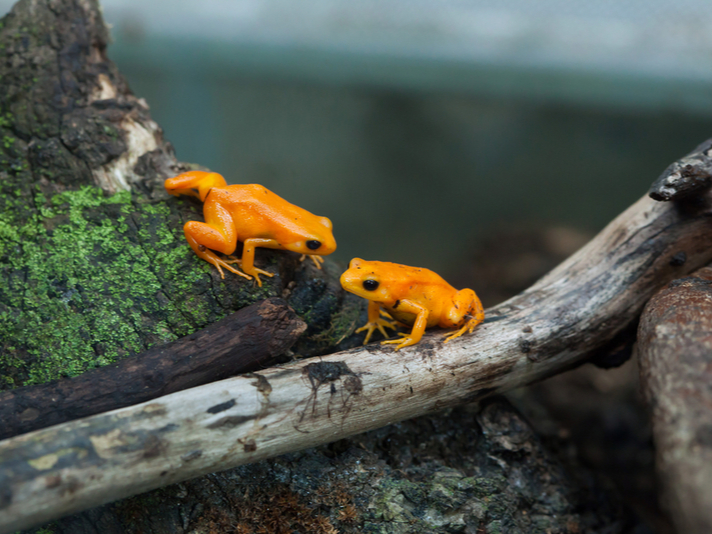
Vladimir Wrangel/Shutterstock
The golden mantella (Mantella aurantiaca) is the most common species in the hobby.
Start out by allowing your tank(s) to dry out a bit. Make sure that the frogs always have access to standing water — you don’t want them to dry out too much! Reduce feeding by about a third. After a couple months of this, mist the enclosure heavily and feed daily. Male mantellas may start calling within the first couple days of misting. Females will generally develop eggs over the next several weeks. If you closely examine a gravid female’s underside, dozens of white eggs will be visible through her translucent belly.
Eggs are deposited in a shallow bowl created by the female in the sphagnum moss. Generally, the egg clutches are placed underneath a piece of cork or other décor, out of sight and protected. Within a few days, a small ridge will form on the eggs if they are fertile. If they haven’t been fertilized by a male, the eggs will begin to fall apart and the clear gel inside will take on a whitish hue.
As mentioned, finding egg clutches inside a naturalistic vivarium can be very difficult, which is why we house our breeding groups in more simplified setups. We check for egg clutches weekly. Once one is found, it and the surrounding sphagnum moss is removed from the tank and placed in an 8-ounce deli cup. Reverse osmosis (R/O) water is added until it saturates the moss, just touching the bottom of the egg clutch. We label the cup with the date the eggs were collected and the species name, as mantella tadpoles and newly morphed froglets look very similar to each other until they are a couple months old.
As the eggs develop and hatch over the next two weeks, freshly hatched tadpoles may feed on unfertilized eggs or their slower-developing clutchmates. Let nature take it’s course! We initially pulled tadpoles as soon as they hatched and noticed a fairly low survival rate. By leaving the tadpoles in their cups for four to five days after the last tadpole hatches, and allowing a bit of predation to occur, we have had a much higher success rate with our mantella tadpoles and froglets.
Once the tadpoles have been free swimming for four to five days, they are ready for a more permanent rearing aquarium. We utilize 20H aquaria with an established sponge filter and Java moss. We tried gravel in the past, but found a bare-bottom tank is much easier to keep clean. A submersible aquarium heater keeps the water in the mid 70s. Start out with about 3 inches of water, then slowly raise the water level every week until the tank is about half full. Change half of the water three to five times a week. For water, we use “tadpole tea,” which is Indian almond leaves that are boiled in R/O water until the water is a dark brown. After it cools, this concentrate is added to R/O water until it has a light yellow hue.
Feed the tadpoles a variety of quality fish and tadpole foods, such as brine shrimp flake, bloodworms and prepared diets two to three times a day. Prior to each feeding, remove any uneaten food from previous feedings using a turkey baster.
Within a few months, mantella tadpoles will develop their rear legs. When you see tadpoles with all four legs, remove them from the water (often, we’ll find them climbing up the sides of the rearing tank), and place them in a large deli cup with damp paper towel and a handful of moist sphagnum. After two or three days, the tadpoles will absorb their tails and begin to move around. This means the young froglets are ready for a rearing container.
Three to five mantellas are housed in a 10-inch deli cup on damp paper towels, with a handful of moist sphagnum on one side. These containers are misted and the frogs are fed daily. The paper towels are changed two to three times a week. Frequent feedings and cleanliness is of the upmost importance.
House young mantellas in this fashion for several months, until the froglets are colored up and eating well. After three to four months, the frogs are ready for a new home in an adult enclosure.
Are mantellas the right frogs for you? Do you like active, colorful pets that are awake when you are? Do you want to build a mini jungle oasis that your pets will be happy to call home? Consider adding these rare jewels of the rain forest to your collection. With a bit of prep, planning, and work, mantellas can provide their keepers with years of enjoyment.
Zach Brinks has kept herps for 25 years and has worked with a diverse range of reptiles and amphibians, with a current focus on frogs. He has a BS in biology from Michigan State University and now holds the Curator of Fauna position at Josh’s Frogs, where he oversees the husbandry and production of thousands of frogs every year.

